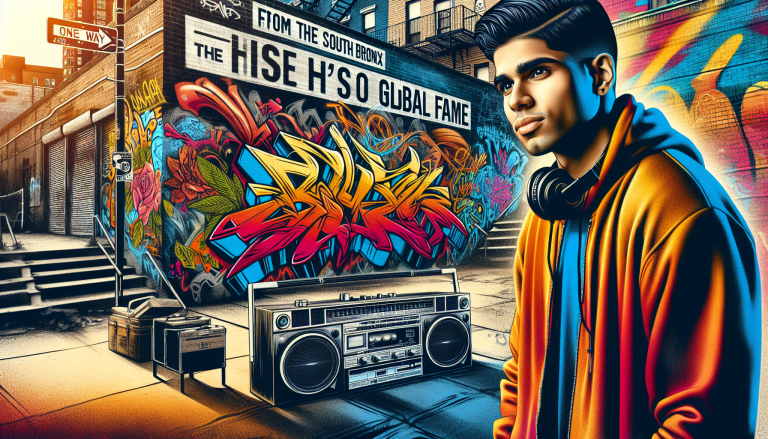The Birth of a Cultural Juggernaut: Historical Context of Hip-Hop
Picture the South Bronx, New York, in the 1970s—a place where economic hardship painted walls with graffiti and city streets pulsed with untamed energy. Out of this furnace rose hip-hop, a genre not just of music but of cultural revolution. Born from block parties and urban expression, hip-hop provided a voice to marginalized communities, transforming the raw sound of the streets into a global phenomenon. DJ Kool Herc, often hailed as the “Father of Hip-Hop,” pioneered the art of breakbeat DJing—extending the instrumental breaks of funk, soul, and disco records to ignite dancefloor frenzy. His innovation was more than technique; it was a declaration that American music was evolving into something new, rooted in rhythm and storytelling.
What followed was a rapid-fire explosion of artistic elements—MCing (the lyrical rhymes), breakdancing, graffiti art, and DJing—that forged what we now cherish as hip-hop culture. These elements were intertwined mirrors reflecting the struggles, triumphs, and aspirations of urban life. Hip-hop was not just music, it was identity, a living, breathing ecosystem shaped by the voices and beats of its creators.
The Rhythmic Soul: A Genre Description
Hip-hop, at its core, is a hypnotic fusion of rhythmic beats, poetic lyrics, and dynamic sounds. Unlike traditional music structures, it thrives on sampling and looping—repurposing snippets of existing tracks to craft entirely new sound canvases. The beat is king, driven by distinctive drum patterns and bass lines that make bodies move and heads nod in sync. The MC, or rapper, articulates sharp insights, storytelling, and social commentary, often with razor-sharp wit and cadence that elevates speech to an art form.

This genre’s sonic palette is vast—from the dusty, soulful grooves of the 1980s to the digital synths and trap beats dominating contemporary charts. Hip-hop’s heartbeat is its beatmaking, where crate digging and sophisticated production tools have become sacred rituals, channeling samples into fresh, boundary-pushing tracks. What distinguishes hip-hop from other American music genres is its capacity to adapt and absorb cultural influences, birthing endless subgenres from gangsta rap’s raw narratives to conscious rap’s enlightening themes.
Icons and Trailblazers: Key Artists and Groups
The pantheon of hip-hop legends reads like a who’s-who of transformative artists who’ve reshaped music and culture. Grandmaster Flash and the Furious Five heralded the genre’s arrival with “The Message,” a searing social critique painted over infectious beats. Run-D.M.C., swaggering with Adidas sneakers and rock-infused riffs, smashed hip-hop into the mainstream mainstream corridors with albums like *Raising Hell*. They broke down racial and musical barriers, proving hip-hop’s universality.
The 1990s witnessed an explosion of voices—the poetic genius of Nas with *Illmatic*, the rebellious grit of Tupac Shakur and The Notorious B.I.G., and the West Coast’s G-Funk groove courtesy of Dr. Dre’s *The Chronic*. Each artist crafted stories layered with nuance, politics, and raw emotion, echoing urban reality. Fast-forward to the 2000s and beyond, Kendrick Lamar rose as a modern prophet of hip-hop, delivering complex, socially conscious masterpieces that reminded the world of the genre’s power as a social mirror.
Female artists like Queen Latifah, Missy Elliott, and Lauryn Hill not only pushed lyrical boundaries but also challenged the male-dominated paradigm, adding diverse voices and perspectives that enriched hip-hop’s narrative depth.
Epic Tracks and Timeless Albums: Notable Soundscapes
Certain songs and albums transcend their eras, becoming cultural landmarks etched in collective memory. “The Message” (1982) by Grandmaster Flash and the Furious Five was hip-hop’s social awakening—its line “Don’t push me ’cause I’m close to the edge” became anthemic for resilience. Run-D.M.C.’s “Walk This Way,” a boundary-breaking collaboration with Aerosmith, fused rock and hip-hop in a way that astonished and united disparate fanbases. It was proof that hip-hop had arrived as a major force in American music.
Nas’s *Illmatic* (1994) remains a blueprint of lyrical excellence and production finesse. Tracks like “N.Y. State of Mind” painted poetic urban landscapes with sonic precision, setting benchmarks for storytelling. Dr. Dre’s *The Chronic* (1992) introduced G-Funk’s signature funk-laden basslines and smooth synths, creating a laid-back West Coast sound that influenced countless artists.
In the contemporary scene, Kendrick Lamar’s *To Pimp a Butterfly* (2015) is a sprawling opus that fuses jazz, funk, and soul with incisive lyrics on race and identity. The album elevated hip-hop into the realm of social critique and art, winning Grammy accolades and critical reverence. These milestones illustrate hip-hop’s journey from street corners to arenas, always evolving yet retaining its truthful core.
Rhythms That Reshape Culture: Lasting Effects of Hip-Hop
Hip-hop’s cultural imprint is seismic. It redefined fashion—think oversized gold chains, sneakers as status symbols, and streetwear brands born from the community ethos. It reshaped language, with slang like “dope,” “bling,” and “flow” seeping into the global lexicon. Hip-hop’s influence extends beyond music into film, dance, art, and political activism, all interwoven threads in a tapestry of cultural change.
As an American music genre, hip-hop’s power lies in its authenticity and adaptability. It democratized music production and storytelling, giving marginalized voices an unprecedented platform that continues to inspire generations worldwide. It has driven innovations in DJ technology and challenged conventional music industry norms, democratizing creativity and distribution with platforms like mixtapes and now streaming.
In clubs and festivals—where EDM (Electronic Dance Music) often dominates the sonic space—hip-hop maintains a vibrant presence, blending seamlessly with dance music’s pulsating energy. The fusion of hip-hop beats with EDM’s electrifying drops is a testament to the genres’ shared love of rhythm and movement, forging new pathways for creative synergy.
“Hip-hop is the streets moving,” said Afrika Bambaataa, one of the culture’s pioneers. And move it has—across continents and cultures, breaking barriers and redefining what American music means. Whether through the pulse of a breakbeat or the poetry of a rhyme, hip-hop continues to command attention, challenge norms, and celebrate the resilience of the human spirit in rhythm and rhyme.